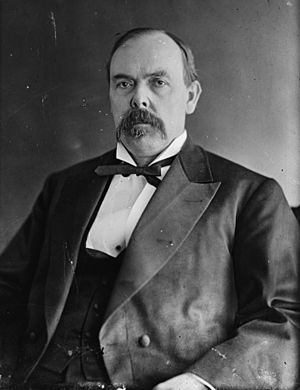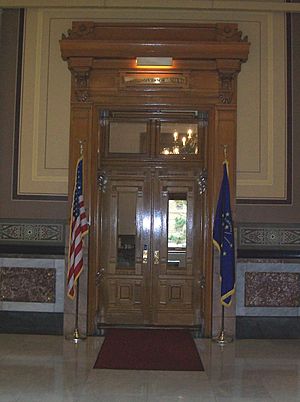Governor of Indiana facts for kids
Quick facts for kids Governor of Indiana |
|
|---|---|

|
|

|
|
| Government of Indiana | |
| Residence | Indiana Governor's Residence |
| Term length | Four years, renewable once in a 12-year period |
| Inaugural holder | Jonathan Jennings |
| Formation | November 7, 1816 |
| Succession | Line of succession |
| Deputy | Lieutenant Governor of Indiana |
| Salary | $221,024 (2025) |
| Website | in.gov/gov |
The governor of Indiana is like the chief executive officer for the state of Indiana. This person leads the state government. The governor is chosen by voters for a four-year term. Their main job is to manage many parts of the Indiana state government.
The governor also works with other elected officials. These officials manage different state agencies. The governor's main office is at the Indiana Statehouse. They also use the Indiana Governor's Residence in Indianapolis for official events.
The current governor is Mike Braun. He is a Republican and became governor on January 13, 2025. He is the 52nd person to hold this important job.
The role of governor has changed a lot over more than 200 years. It became much stronger after the mid-1900s. Before that, governors often had to struggle with the Indiana General Assembly (the state's lawmaking body) and the Indiana Supreme Court. They worked to make the governor's office an equal part of the state government. Even with more power now, Indiana's governors have less power than governors in many other states.
The Governor's Job
What Powers Does the Governor Have?
The governor's powers are written in Article V of the Constitution of Indiana. The governor has some power to manage the state government. However, many state agencies are run by other officials who are also elected by the people.
The governor works with the state legislature, called the Indiana General Assembly. This assembly has two parts: the Indiana House of Representatives and the Indiana Senate. The governor also works with the Indiana Supreme Court.
The governor can say "no" to (veto) laws passed by the General Assembly. If a bill is vetoed, it goes back to the General Assembly. Unlike many other states, Indiana's General Assembly can override a veto with a simple majority vote. This means more than half of the members in both parts of the assembly must vote to pass the bill again.
One important power the governor has is calling a special meeting of the General Assembly. The assembly can only meet for 91 days on its own every two years. This short time often means they can't pass all the laws they want. This gives the governor a lot of influence. Lawmakers might agree with the governor on some issues to get a special session.

The governor can also call out the state's defense forces. This includes the Indiana Guard Reserve or the Indiana National Guard. This happens during emergencies or disasters. The governor is also in charge of making sure all state laws are followed. This is done through the Indiana State Police.
The governor can also grant a pardon or reduce the sentence of someone convicted of a crime. This is not allowed in cases of treason or if someone is removed from office (impeached).
Besides the powers in the Constitution, governors also have powers given to them by laws. Most of the governor's daily work comes from these laws. This means the General Assembly can increase or decrease the governor's power. In the past, the General Assembly would shift control of agencies. They would give control to or take it from the governor based on political parties.
The governor can also influence the state court system. They do this by appointing judges. When a judge's spot opens on the Supreme Court, Tax Court, or circuit courts, a special group interviews candidates. This group sends a list of three names to the governor. The governor then chooses one. For other court judges who are usually elected, the governor can appoint someone if a spot opens up. This person holds the job until the next election. This power helps the governor shape who serves in the courts.
The governor of Indiana earns a yearly salary. In 2021, this was about $134,051. They also get extra money for official spending.
Who Can Be Governor?
To become governor of Indiana, a person must be a U.S. citizen. They must have lived in Indiana for five years in a row before the election. Candidates must also be at least 30 years old when they start the job.
The governor cannot hold any other state or federal job while in office. They must quit any other job before becoming governor. Before starting, the candidate takes an oath of office. The Chief Justice of the Indiana Supreme Court gives this oath. The governor promises to support the laws of the U.S. and Indiana.
How Long Does a Governor Serve?
The governor serves for four years. Their term starts on the second Monday in January. They stay governor until the next person takes the oath. A governor's term can end sooner if they resign, die, become unable to do the job, or are impeached.
There is no limit to how many terms a governor can serve in total. However, a governor can only serve up to eight years in any 12-year period. This means they can serve two full terms in a row. To run for a third term, they would have to wait out one election period.
What Happens if the Governor Can't Serve?
If the governor becomes unable to do their job, the Lieutenant Governor of Indiana steps in. The lieutenant governor becomes the acting governor until the governor recovers. Only two governors have become unable to serve during their terms. If this happens, the governor's office tells the lieutenant governor. The lieutenant governor then decides to become acting governor by telling the General Assembly in a letter. The governor can get their powers back by sending another letter to the General Assembly.
If the governor resigns, dies, or is removed from office (impeached and convicted), the lieutenant governor becomes the new governor. If the lieutenant governor's office is also empty, then the president pro tempore of the Senate becomes governor. If that spot is also empty, the Senate must choose someone to fill the governor's office.
Where Does the Governor Live and Work?
The governor has an office on the first floor of the Indiana Statehouse in Indianapolis. From there, they manage the state agencies under their control. The Statehouse is also home to the Indiana General Assembly and the Indiana Supreme Court. Other elected officials, like the attorney general and lieutenant governor, also have offices there. Most state offices are in a separate state office building.
Traditionally, the governor lives in the Indiana Governor's Residence in Indianapolis. However, some governors have chosen to keep their private homes. They use the Governor's Residence only for official events.
History of Indiana's Governors
Early Governors and Changes
The first governor of Indiana was Jonathan Jennings. He was elected in August 1816 and started his job in December of that year. The first state capital was in Corydon. The first three governors lived and worked there. The capital moved to Indianapolis in December 1824.
Governors first served three-year terms. This changed when the state's constitution was updated in 1851. The 1851 constitution made terms four years long. It also stopped governors from serving terms right after each other. In 1972, the constitution was changed again. This allowed governors to serve consecutive terms, but limited them to two terms in a row.
There have been 51 governors of Indiana. Many have been from the Republican Party (23) and the Democratic Party (21). Four governors have died while in office. Seven have resigned. Ten lieutenant governors have become governor. Only one Senate president pro tempore, James B. Ray, has become governor.
The first governor, Jonathan Jennings, faced an attempt to remove him from office (impeachment). This was because of his actions during a treaty negotiation in 1819. The evidence against him was destroyed, and the case was dropped. Another attempt to impeach Governor James B. Ray in 1826 also failed.
Three governors later became Vice President of the United States. Two of them were still governors when they were elected Vice President.

How the Governor's Power Changed
Historically, Indiana's governor had less power compared to other parts of the state government. They also had less power than governors in most other U.S. states. When Indiana was a territory, people didn't like how much power the territorial governors had. So, when the state's first constitution was written, they created a weak governor's office. The governor didn't have full control over the military. Their term was only three years. The General Assembly could easily overturn most of their decisions.
Over time, the legislature continued to weaken the governor's role. The 1851 constitution limited the governor even more. The governor could no longer choose judges for state courts. They also couldn't appoint their own cabinet members. These cabinet members became elected by the people, making them independent. The governor also lost the power to suggest state budgets. Serving terms right after each other was banned. Meanwhile, the Supreme Court became very independent, and the General Assembly gained many powers taken from the governor.

Governors started to gain more power during the American Civil War. The General Assembly tried to take control of the military from the governor. In response, the General Assembly was basically shut down. During this time, the governor took on many new powers. These included appointing public officials, hiring and firing state employees, and managing state money. When the General Assembly met again, with many members who supported the governor, he was allowed to keep many of these new powers.
In the 1930s, during the Great Depression, governors again started to gain more power. A law called the Executive Reorganization Act was passed. This gave the governor a lot of power to appoint people to jobs. New state welfare and regulatory agencies were put directly under the governor's control. This greatly expanded the governor's role in running the state. It also created many jobs the governor could give out. The legislature tried to create a system where jobs were given based on skill, but it was hard to enforce.
The struggle between the governor and the legislature continued. In 1941, the legislature changed the Executive Reorganization Act. They replaced it with the State Administration Act. This put most of the government under the control of elected officials. It reduced the governor's power to mainly leading the military and carrying out laws. This issue went to the Indiana Supreme Court. The court ruled for the first time that the governor was indeed the chief executive of the state. They said the legislature could not pass laws that took away this right. This decision was a big change and gave governors a legal way to protect their powers in the future.
In the 1970s, several changes to the constitution were passed. These changes, supported by popular governors, increased their powers. State judges were again appointed, but a special commission chose the candidates. However, the governor gained more control over this process. Another change removed the ban on serving consecutive terms. This allowed Indiana to have governors serve back-to-back terms for the first time in over 100 years. A third change gave the power to prepare the state budget to a State Budgetary Agency. This agency was run by officials chosen by the governor. This gave the governor a lot of power over the budget.
Even with these gains, Indiana's governor is still less powerful than governors in many other states. The governor cannot veto specific parts of a bill (line-item veto). Also, if a governor doesn't sign or reject a bill, it automatically becomes law. The legislature can override a veto with a simple majority, which is easier than the two-thirds majority often needed in other states. The legislature still has the final say on hiring state employees. However, because the government is so big and legislative sessions are short, they can't make a huge impact. The governor's cabinet is still mostly independent. The governor only controls about half of the state's agencies, like the Indiana State Police. Other big agencies are controlled by the cabinet.
How Governors Use Vetoes
In Indiana's early history, governors rarely used their veto power. This was because the General Assembly could easily override a veto with a simple majority. Governor James Whitcomb was the first to use the veto often. He vetoed 15 bills in one legislative session. Roger Branigin vetoed the most bills of any governor, sending back 100 bills.
Even though vetoes are easy to override, only about 10% of vetoed bills are actually overridden. For example, in the 1970s, 117 bills were vetoed, but only 11 were overridden. Experts say this is because legislative sessions are short. There often isn't enough time for many bills to go through both houses twice. Also, lawmakers from the same party as the governor usually don't vote to override his veto, even if they supported the bill at first.
Working with the General Assembly
The governor's relationship with the General Assembly is usually key to their success. If the governor's party controls the assembly, it's often easier to pass their plans. Since political parties became strong in 1831, the legislature has been divided with different parties controlling the House and Senate in 33 sessions. Only five times has the opposition party controlled the entire legislature. In 98 sessions, the governor's party controlled the whole assembly.
Governors who were lawmakers before becoming governor often had more success. Three speakers of the House have become governor. Governor Joseph A. Wright had the worst relationship with the assembly. He once gave speeches accusing them of corruption. The legislature responded by overriding all his vetoes against banks. He was so disliked by his own party that they removed him after his term.
Facts About Indiana's Governors
Most of Indiana's governors have been married when they were elected. Only James Whitcomb was not, but he married while in office. About half of the governors have been married more than once, usually because their first wives passed away. Three governors' wives died while their husbands were in office.
Except for Jonathan Jennings, Thomas R. Marshall, and Eric Holcomb, all governors have had children. After leaving office, Thomas R. Marshall adopted a boy. Only 20 of Indiana's governors were born in the state. Many came from other states like Pennsylvania, Ohio, and Kentucky.
The youngest person to be a governor was William Henry Harrison. He was a territorial governor at age 27. James B. Ray was the youngest elected governor at 31. Evan Bayh, at 34, is the only other elected governor under 40. James D. Williams, at 69, was the oldest elected governor and died in office at 72. The average age of governors when elected is 50.
Thirty-two of Indiana's governors have served in the military. Being a veteran has often helped people become governor. Many governors were also lawyers (30 of them). Three were farmers. Thirty governors went to college, and 11 of them attended Indiana University. Several governors have gone on to higher offices. Nine have served in the United States Senate, and three have become Vice President of the United States.
How Governors Are Elected
Under the first constitution from 1816, Indiana held elections for governor every three years. The very first election happened in August 1816, even before Indiana officially became a state. Until the constitution changed in 1851, elections were in October, and winners started their jobs in December.
In 1851, Indiana adopted its second constitution. This new constitution said governors could not serve terms right after each other. It also made terms four years long. Since then, elections have been held on Election Day in November. These elections happen in years that can be divided by four, at the same time as presidential elections. In 1972, the constitution was changed again. This allowed governors to serve terms right after each other. However, it limited them to a total of eight years in any 12-year period. This means they can serve two terms in a row.
Timeline
| Timeline of Indiana governors |
 |




